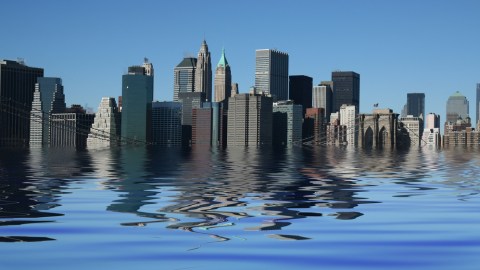Paradise Lost: What if Manhattan is the Next Maldives?

The latest climate change catastrophe scenario is now out: rising sea levels over the next century could flood 3.7 million people in over 500 U.S. cities, including New York, New Orleans and Miami. This scenario from Climate Central follows other reports, such as one this week by the Asian Development Bank that outlines a scenario in which one-third of South East Asia would be uninhabitable as a result of rising sea levels. If climate change continues unabated, it could lead to mass migrations of tens of millions of people as they flee natural disasters brought on by climate change. As if to underscore this point, just this week, the inhabitants of the island of Kiribati announced plans to pack up en masse and migrate to Fiji.
The Maldives – a collection of nearly 1,200 islands off the coast of India in the Pacific Ocean – are the classic example of the link between global warming, rising sea levels and environmental catastrophe. Within our lifetime, the Maldives may no longer exist, despite courageous efforts by politicians like Mohamed Nasheed, who led a much-publicized effort to save the nation from climate change that was later made into a documentary film called The Island President. This tiny island-nation (often described as one of the most beautiful places on earth) holds the unlikely distinction of being the first country in history that may need to completely abandon its homeland due to rising sea levels.The highest point in the Maldives is just eight feet above sea level, but much of the country is just four feet above sea level, meaning that any rise in sea level could bring with it the threat of flooding, coastal erosion and the salination of freshwater supplies. During the 2004 Asian tsunami, the entire country briefly found itself entirely submerged by water.
Right now, the disappearing islands of the Maldives are off the radar of most Americans – unless you happen to be part of the 1% of the nation planning to book a high-end tourism package. In the documentary film The Island President, this is a point repeatedly made by former President Mohamed Nasheed: the largest nations of the world have largely forgotten about the Maldives. After all, if you are a tiny nation without any geostrategic value (i.e. oil), will Americans really care about your future? From this perspective, efforts in the Maldives to reverse the effects of global warming – like erecting solar panels on the rooftops of entire villages and turning the entire country into a shark sanctuary – sound Quixotic at best, hopeless at worst.
What happens, though, when the disappearing islands are not the Maldives but, instead, the island of Manhattan?
Suddenly, the stakes are higher. Imagine the tallest skyscrapers of Manhattan, completely submerged by water. This sounds like a scenario from one of those apocalyptic disaster movies about New York that always seem to make their way into movie cinemas during the summer popcorn season — but it could actually happen. It’s not only the recent report from Climate Central — scientists from Princeton and MITrecently outlined a scenario in which killer hurricanes could pound New York City over the next century:
“Under the worst-case scenario, a hurricane the size of the one that hit New York City in 1821 — which buried Manhattan under 10 feet of water –would have to strike at high tide. In the Princeton simulation, a storm of that magnitude could put Manhattan under more than 15 feet of water. Manhattan’s current sea wall is just five feet tall, which, even under present conditions, makes it “highly vulnerable to extreme hurricane-surge flooding,” the report says.”
In the preparations ahead of the arrival of Hurricane Irene last year, NYC Mayor Michael Bloomberg took the unprecedented steps of evacuating low-lying coastal areas of the city – including Lower Manhattan and parts of Brooklyn and Queens – amidst predictions that a high storm surge could flood parts of the city. As breathless newscasts from talking head pundits on cable TV warned, the type of killer, once-in-a-century storm is due, sooner or later, to hit New York City. The last major hurricane to hit the city was in 1893. As they say in the world of high-stakes gambling, “we’re due.”
Of course, skeptics abound when it comes to these dire tales of climate change. Remember 2006, when the story of the “disappearing islands” of Lohachara turned out to be a preposterous Internet hoax? These false alarms only fuel the arguments of climate-change skeptics. Most recently, Republican candidate Rick Santorum pointed to climate change as one of those ideological issues best saved for environmentalist radicals.
The disappearing civilizations of the world have always held a fascination in the collective global consciousness. The story of the fabled city of Atlantis is a massive tourist draw in both the Bahamas and Dubai. Is it possible that, within our generation, the world’s eco-tourists will be visiting the Underwater World of Manhattan, including a partially submerged Statue of Liberty? Paradise lost, indeed.
image: Manhattan Submerged / Shutterstock





